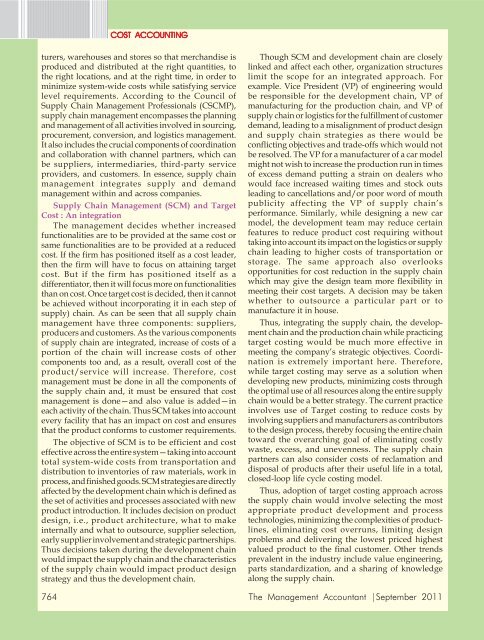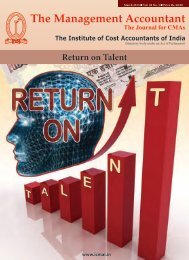This Issue - Icwai
This Issue - Icwai
This Issue - Icwai
You also want an ePaper? Increase the reach of your titles
YUMPU automatically turns print PDFs into web optimized ePapers that Google loves.
COST COST ACCOUNTING<br />
ACCOUNTING<br />
ACCOUNTING<br />
turers, warehouses and stores so that merchandise is<br />
produced and distributed at the right quantities, to<br />
the right locations, and at the right time, in order to<br />
minimize system-wide costs while satisfying service<br />
level requirements. According to the Council of<br />
Supply Chain Management Professionals (CSCMP),<br />
supply chain management encompasses the planning<br />
and management of all activities involved in sourcing,<br />
procurement, conversion, and logistics management.<br />
It also includes the crucial components of coordination<br />
and collaboration with channel partners, which can<br />
be suppliers, intermediaries, third-party service<br />
providers, and customers. In essence, supply chain<br />
management integrates supply and demand<br />
management within and across companies.<br />
Supply Chain Management (SCM) and Target<br />
Cost : An integration<br />
The management decides whether increased<br />
functionalities are to be provided at the same cost or<br />
same functionalities are to be provided at a reduced<br />
cost. If the firm has positioned itself as a cost leader,<br />
then the firm will have to focus on attaining target<br />
cost. But if the firm has positioned itself as a<br />
differentiator, then it will focus more on functionalities<br />
than on cost. Once target cost is decided, then it cannot<br />
be achieved without incorporating it in each step of<br />
supply) chain. As can be seen that all supply chain<br />
management have three components: suppliers,<br />
producers and customers. As the various components<br />
of supply chain are integrated, increase of costs of a<br />
portion of the chain will increase costs of other<br />
components too and, as a result, overall cost of the<br />
product/service will increase. Therefore, cost<br />
management must be done in all the components of<br />
the supply chain and, it must be ensured that cost<br />
management is done—and also value is added—in<br />
each activity of the chain. Thus SCM takes into account<br />
every facility that has an impact on cost and ensures<br />
that the product conforms to customer requirements.<br />
The objective of SCM is to be efficient and cost<br />
effective across the entire system—taking into account<br />
total system-wide costs from transportation and<br />
distribution to inventories of raw materials, work in<br />
process, and finished goods. SCM strategies are directly<br />
affected by the development chain which is defined as<br />
the set of activities and processes associated with new<br />
product introduction. It includes decision on product<br />
design, i.e., product architecture, what to make<br />
internally and what to outsource, supplier selection,<br />
early supplier involvement and strategic partnerships.<br />
Thus decisions taken during the development chain<br />
would impact the supply chain and the characteristics<br />
of the supply chain would impact product design<br />
strategy and thus the development chain.<br />
Though SCM and development chain are closely<br />
linked and affect each other, organization structures<br />
limit the scope for an integrated approach. For<br />
example. Vice President (VP) of engineering would<br />
be responsible for the development chain, VP of<br />
manufacturing for the production chain, and VP of<br />
supply chain or logistics for the fulfillment of customer<br />
demand, leading to a misalignment of product design<br />
and supply chain strategies as there would be<br />
conflicting objectives and trade-offs which would not<br />
be resolved. The VP for a manufacturer of a car model<br />
might not wish to increase the production run in times<br />
of excess demand putting a strain on dealers who<br />
would face increased waiting times and stock outs<br />
leading to cancellations and/or poor word of mouth<br />
publicity affecting the VP of supply chain’s<br />
performance. Similarly, while designing a new car<br />
model, the development team may reduce certain<br />
features to reduce product cost requiring without<br />
taking into account its impact on the logistics or supply<br />
chain leading to higher costs of transportation or<br />
storage. The same approach also overlooks<br />
opportunities for cost reduction in the supply chain<br />
which may give the design team more flexibility in<br />
meeting their cost targets. A decision may be taken<br />
whether to outsource a particular part or to<br />
manufacture it in house.<br />
Thus, integrating the supply chain, the development<br />
chain and the production chain while practicing<br />
target costing would be much more effective in<br />
meeting the company’s strategic objectives. Coordination<br />
is extremely important here. Therefore,<br />
while target costing may serve as a solution when<br />
developing new products, minimizing costs through<br />
the optimal use of all resources along the entire supply<br />
chain would be a better strategy. The current practice<br />
involves use of Target costing to reduce costs by<br />
involving suppliers and manufacturers as contributors<br />
to the design process, thereby focusing the entire chain<br />
toward the overarching goal of eliminating costly<br />
waste, excess, and unevenness. The supply chain<br />
partners can also consider costs of reclamation and<br />
disposal of products after their useful life in a total,<br />
closed-loop life cycle costing model.<br />
Thus, adoption of target costing approach across<br />
the supply chain would involve selecting the most<br />
appropriate product development and process<br />
technologies, minimizing the complexities of productlines,<br />
eliminating cost overruns, limiting design<br />
problems and delivering the lowest priced highest<br />
valued product to the final customer. Other trends<br />
prevalent in the industry include value engineering,<br />
parts standardization, and a sharing of knowledge<br />
along the supply chain.<br />
764 The Management Accountant |September 2011




